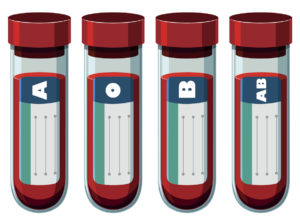 February is National Nutrition Month, and in honor of that, let’s take a look at a diet theory that gained popularity in 1997 and see if it is nutritionally sound. The Blood-Type Diet Theory hit the diet scene promising wonderful results. The idea of eating a diet based on your blood-type was first published in Eat Right for Your Type, written by naturopath Peter D’Adamo. Read more about the Blood Type Diet here.
February is National Nutrition Month, and in honor of that, let’s take a look at a diet theory that gained popularity in 1997 and see if it is nutritionally sound. The Blood-Type Diet Theory hit the diet scene promising wonderful results. The idea of eating a diet based on your blood-type was first published in Eat Right for Your Type, written by naturopath Peter D’Adamo. Read more about the Blood Type Diet here.
D’Adamo’s theory is that the best diet for each person is based on their ABO blood type—the classification system for determining what type of antibodies are in each person’s blood. D’Adamo believed our ancestors’ dietary habits have a lingering affect in our bloodstream today and we should eat based on what our ancestors ate. He believed that by adhering to a diet matching your blood type, humans can improve health and decrease risk of chronic illness such as cardiovascular disease. This book was a New York Times best-seller that sold over 7 million copies.
Different Diets Based on Blood Type
Here is how D’Adamo divided up the 4 blood types and the diet they should eat:
Type A: Called the agrarian, or cultivator. People who are type A should eat a diet rich in plants, and completely free of “toxic” red meat. This closely resembles a vegetarian diet.
Type B: Called the nomad. These people can eat plants and most meats (except chicken and pork), and can also eat some dairy. However, they should avoid wheat, corn, lentils, tomatoes and a few other foods.
Type AB: Called the enigma. Described as a mix between types A and B. Foods to eat include seafood, tofu, dairy, beans and grains. They should avoid kidney beans, corn, beef and chicken.
Type O: Called the hunter. This is a high-protein diet based largely on meat, fish, poultry, certain fruits and vegetables, but limited in grains, legumes and dairy. It closely resembles the paleo diet.
Bottom Line
Joe Leech, who holds a Masters of Science in Nutrition and frequently writes about health had this to say about the diet theory:
“ I think any of these dietary patterns would be an improvement for most people, no matter what their blood type is. All 4 diets …are mostly based on real, healthy foods, and a huge step up from the standard Western diet of processed junk food.”
This was also what the University of Toronto discovered. After studying 1,455 subjects, “The way an individual responds to any one of these diets has absolutely nothing to do with their blood type and has everything to do with their ability to stick to a sensible vegetarian or low-carbohydrate diet,” said Dr. Ahmed El-Sohemy, Associate Professor and Canada Research Chair in Nutrigenomics at the U of T.
So, in National Nutrition Month, remember that finding an eating plan that works for you is the most important criteria. Very few diets are a “magic bullet” to success. If you are looking for a new way of eating, check out our blog article from January 1, 2017, Do You Practice Mindful Eating? Find a method of healthy eating that you enjoy. That’s the key to dietary health.





